
USS Wasp (CV-7) was a United States Navy aircraft carrier commissioned in 1940 and lost in action in 1942. She was the eighth ship named USS Wasp, and the sole ship of a class built to use up the remaining tonnage allowed to the U.S. for aircraft carriers under the treaties of the time. As a reduced-size version of the Yorktown-class aircraft carrier hull, Wasp was more vulnerable than other United States aircraft carriers available at the opening of hostilities. Wasp was initially employed in the Atlantic campaign, where Axis naval forces were perceived as less capable of inflicting decisive damage. After supporting the occupation of Iceland in 1941, Wasp joined the British Home Fleet in April 1942 and twice ferried British fighter aircraft to Malta.

Strike Fighter Squadron 11 (VFA-11) is a United States Navy strike fighter squadron stationed at Naval Air Station Oceana, Virginia, United States. The squadron was established in 1950 and is nicknamed "Red Rippers". VFA-11 is equipped with the Boeing F/A-18F Super Hornet and currently assigned to Carrier Air Wing One.
Fighter Squadron 11 or VF-11 was an aviation unit of the United States Navy. It was originally established as VF-5 on 1 February 1927, redesignated as VF-5S on 1 July 1927, redesignated as VF-5B in January 1928, redesignated VB-1B on 1 July 1928, redesignated VF-5B on 1 July 1930, redesignated VF-5S in July 1932, redesignated VF-5B in April 1933, redesignated VF-4 on 1 July 1937, redesignated VF-41 on 15 March 1941, redesignated VF-4 on 4 August 1943, redesignated VF-1A on 15 November 1946, redesignated VF-11 on 2 August 1948 and disestablished on 15 February 1959. It was the second US Navy squadron to be designated VF-11.
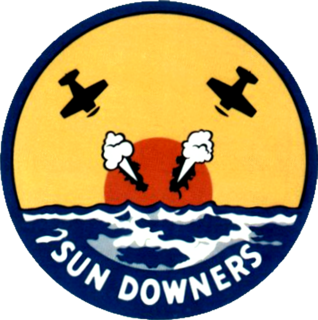
Fighter Squadron 111 (VF-111), also known as the Sundowners, was a fighter squadron of the United States Navy. Originally established as Fighter Squadron 11 (VF-11) on 10 October 1942, it was redesignated as VF-11A on 15 November 1946, redesignated as VF-111 on 15 July 1948 and disestablished on 19 January 1959. On 20 January, another squadron, VF-111 (1956-95) then assumed the designation until its de-establishment in 1995. In November 2006, VFC-13 Detachment Key West was redesignated as VFC-111, taking on the Sundowner insignia and callsign.
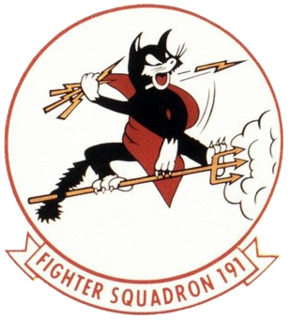
Fighter Squadron 191 (VF-191) was an aviation unit of the United States Navy. It was established in 1943 and disestablished in 1978. The squadron was nicknamed Satan's Kittens. A second VF-191, bearing the same designation and nickname was established for a short time again between 1986 and 1988.

Fighting Squadron 10 (VF-10), also known as the "Grim Reapers", was an aviation unit of the United States Navy, established on 3 June 1942 and disestablished on 26 November 1945.
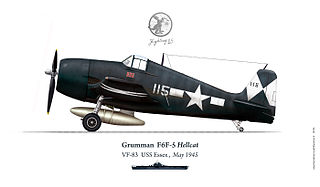
Fighter Squadron 83 or VF-83 was an aviation unit of the United States Navy. Originally established on 1 May 1944, it was disestablished on 24 September 1945. It was the first US Navy squadron to be designated as VF-83.

Fighter Squadron Composite 111 (VFC-111) Sun Downers is a US Navy Reserve adversary squadron based at Naval Air Station Key West, Florida (USA). Currently, it operates Northrop F-5N/F Tiger-IIs, of most of which are single-seater F-5Ns and one twin-seater F-5F, the "FrankenTiger". The Squadron is composed of experienced active duty junior officers, full-time support reservists, and selective reserves. This gives the squadron cutting edge real-world experiences, as well as leveraging off experience and retaining talented instructors that have left active service.
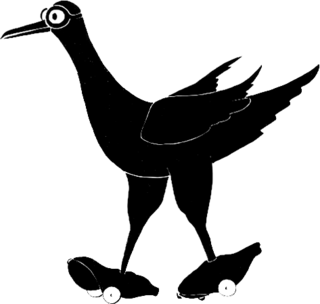
Fighting Squadron 42 or VF-42 was an aviation unit of the United States Navy. Originally established as Scouting Squadron 1B (VS-1B) in May 1928, it was redesignated as VS-1S in 1930, redesignated as VS-1B in 1931, redesignated as VS-41 on 1 July 1937, redesignated as VF-42 on 15 March 1941 and disestablished on 22 June 1942. It was the first US Navy squadron to be designated as VF-42.

Palikulo Bay Airfield or Bomber Field #1 is a former World War II airfield on the island of Espiritu Santo in the New Hebrides Islands at the Espiritu Santo Naval Base.

Fighter Squadron 52 or VF-52 was an aviation unit of the United States Navy. Originally established as Bombing Fighting Squadron 5 (VBF-5) on 8 May 1945, it was redesignated Fighting Squadron 6A (VF-6A) on 15 November 1946, redesignated as Fighter Squadron 52 (VF-52) on 16 August 1948 it was disestablished on 23 February 1959. It was the third US Navy squadron to be designated as VF-52.
Fighter Squadron 71 or VF-71 was an aviation unit of the United States Navy. Originally established as VGS-18 on 15 October 1942, it was redesignated VC-18 on 1 March 1943, redesignated as VF-36 on 15 August 1943, redesignated as VF-18 on 5 March 1944, redesignated as VF-7A on 15 November 1946, redesignated as VF-71 on 28 July 1948 and disestablished on 31 March 1959.
Fighter Squadron 33, or VF-33, was an aviation unit of the United States Navy. Originally established as Escort-Scouting Squadron 16 or VGS-16 on 6 August 1942, it was redesignated as Composite Squadron 16 or VC-16 on 1 March 1943, redesignated as VF-33 on 15 August 1943, and disestablished on 19 November 1945. It was the first US Navy squadron to be designated as VF-33.
Fighting Squadron 2 or VF-2 was an aviation unit of the United States Navy. Originally established as VF-2 on 1 January 1927, it was redesignated VF-2B on 1 July 1927, redesignated as VF-2S on 1 July 1932, redesignated as VF-2B in April 1933, redesignated as VF-2 on 1 July 1937, it was disestablished on 1 July 1942. It was the second US Navy squadron to be designated as VF-2.
Fighting Squadron 72 or VF-72 was an aviation unit of the U.S. Navy, originally established as VF-7 on 1 July 1939, it was redesignated as VF-72 on 19 November 1940 and disestablished on 29 March 1943.
Fighting Squadron 9 or VF-9 was an aviation unit of the U.S. Navy, originally established on 1 March 1942, it was disestablished on 28 September 1945.
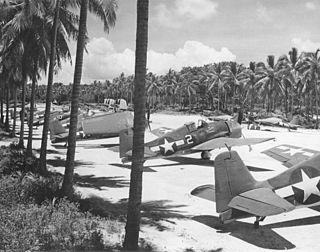
Fighter Squadron 40 or VF-40 was an aviation unit of the United States Navy. Originally established on 15 June 1943, it was disestablished on 19 November 1945. It was the only US Navy squadron to be designated as VF-40.
Fighter Squadron 38 or VF-38 was an aviation unit of the United States Navy. Originally established on 20 June 1943, it was disestablished on 31 January 1946. It was the only US Navy squadron to be designated as VF-38.

Fighter Squadron 80 or VF-80 was an aviation unit of the United States Navy. Originally established on 1 February 1944, it was disestablished on 16 September 1946. It was the first US Navy squadron to be designated VF-80.











